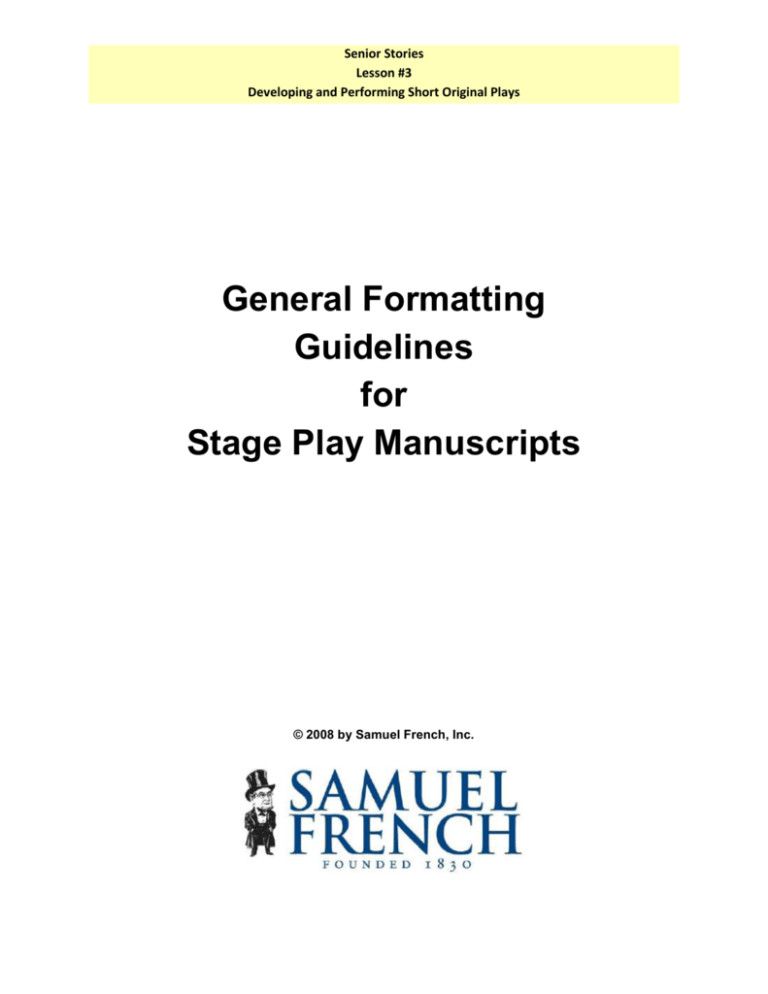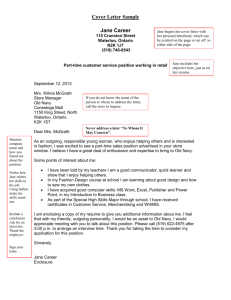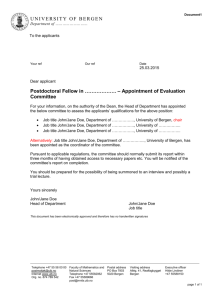Playwriting Formatting Guidelines
advertisement

Senior Stories Lesson #3 Developing and Performing Short Original Plays General Formatting Guidelines for Stage Play Manuscripts © 2008 by Samuel French, Inc. Senior Stories Lesson #3 Developing and Performing Short Original Plays FORMATTING GUIDELINES These guidelines are designed for Microsoft Word or a similar word processing program. Cover Page Your play should have standard one-inch margins. The cover page should only contain: Title and Subtitle, centered, approximately halfway down the page. Standard Format The text of the play should be in standard play format, which looks professional, makes reading easy, and provides our readers with an estimation of run-time. If you are using screenwriting software, please note that its default settings are not necessarily standard play format. Basics. All text should be single-spaced, in a readable font, such as 12 point Times New Roman. When separating characters’ lines or longer stage directions, double space. Song lyrics should be in ALL CAPS, with one indent. (Note that one indent is 12 spaces in Times New Roman or 5 spaces in Courier New.) We prefer continuous pagination (not resetting at the start of an act or scene). The title page should never be numbered. Page one should be the first page of the play. Ideally, the Acts and Scenes will also be included in the pagination. For example, if there is text for Act II, Scene 1 on page 51 of your script, it would read as follows: II – 1 – 51 Cast and Setting. After your cover page, there should be a brief cast of characters, as well as time and place notes. Character names, ages, genders, and any short but important physical characteristics belong here. If doubling is possible, it should be mentioned here, as well. Acts and Scenes. Each new act and/or scene should be started on a new page and be center justified. The act should be written in ALL CAPS and roman numerals, while the scenes should be in capital and small letters, a double space below and underscored, as follows: ACT II Scene 6 You should include a description of the setting and activity at the beginning of each scene. These can be simply designated by the terms “Setting” and “At Rise.” An act or scene should be noted, with “Blackout,” “Curtain,” etc. The end of the play should also be noted. Senior Stories Lesson #3 Developing and Performing Short Original Plays Dialogue and Direction. When a character is speaking, his or her name should be either centered or set 3.5” from the Left Edge of the Paper in ALL CAPS. If continuing a character’s speech from a previous page, insert (Cont.) after the name on the same line. Any other brief direction (one-word) can also go on this line in parentheses. Longer directions belong on the following line in parentheses, three indents in. JOHN (laughing) Text would go here. Emphasis may be indicated by italics or underlining. OR JOHN (Tosses keys across room while laughing) If you have longer directions, move to the next line and use three indents. (JANE walks across room to pick up keys. She shakes some dust from them and unlocks the door.) Then continue dialogue after one space. Note that characters’ names in directions are in ALL CAPS. Stage directions may either go to the right bound of the page or stop at three indents from the right. They should always begin three indents from the left. Simultaneous dialogue should be placed side-by-side, spaced to start and end at the same place on the page. Trailing off should be indicated with ellipsis (…) whereas being cut off should be indicated with a dash. An example of a properly formatted cover page and a play in standard play formatting is included below. Senior Stories Lesson #3 Developing and Performing Short Original Plays TITLE Sub-Title Senior Stories Lesson #3 Developing and Performing Short Original Plays Cast of Characters JOHN DOE: 45 years old, a university professor. JENNIFER DOE: 42 years old, a caterer, John’s wife. JANE DOE: 20 years old, a student, John and Jane’s daughter. Place The Doe Home in Maplewood, New Jersey Time Late Fall Senior Stories Lesson #3 Developing and Performing Short Original Plays I–1–1 ACT I Scene 1 Setting: doors, This is where you describe what is present on the stage, such as furniture, shape of the space, etc. At Rise: This is where you describe the action taking place when the lights are brought up on the stage, such as: John is discovered sitting in a chair. Jane is looking out the window. JOHN (patiently.) Xxxxxxxxxxxxxxxxxxxxxxxxxxxxxxxxxxxxxxxxxxxxxxxxxxxxxxxxxxxxxxx. JANE Xxxxxxxxxxxxxxxxxxxxxxxxxxxxxxxxxxxxxx. (Enter JENNIFER, left.) JENNIFER Xxxxxxxxxxxxxxxxxxxxxxxxxxxxxxxxxxxxxxxxxxxxxxxxxxxxxxxxxxxxxxxxxxxxxxxxxxxxx xxxxx. JANE Xxxxxxxxxxxxxxxxxxxxxxxxxxxx. JENNIFER Xxxxxxxxxxxxxxxxxxxxxxxxxxxxxxxxxxxxxxxxxxxxxxxxxxxxxxxxxxxxxxx… JOHN Xxxxxxxxxxxxxxxxxxxxxxxxxxxxxxxxxxxxxxxxxxxxxxxxxxxxxxxxxxxxxxxxxxxxxxxxxxxxx xxxxx. JANE Xxxxxxxxxxxxxxxxxxxxxxxxxxxxxxxxxxxxxxxxxxxxxxxxxxxxxxxxxxxxxxxxxxxxxxxxxxxxx xxxxxxxxxxxxxxxxxxxxxxxxxxxxxxxxxxxxxxxxxxxxxxxxxxxx. JOHN Xxxxxxxxxxxxxxxx! (Exit JOHN, left.) Senior Stories Lesson #3 Developing and Performing Short Original Plays I–1–2 JANE Xxxxxxxxxx. JENNIFER Xxxxxxxxxxxxxxxxxxxxxxxxxxxxxx. JANE (Looking at letter in JENNIFER’s hand.) Xxxxxxxxxxxxxxxxxxxxxxxxxx. JENNIFER Xxxxxxxxxxxx. JANE Xxxxxxxxxx. (Looking off right.) Xxxxxxxxxxxxxxxxxxxxxxxxxxxxxxxxxxxxxxxxxxxxx. JANE JENNIFER Xxxxxxxxxx. Xxxxxxxxxxx. (They run off.) CURTAIN






